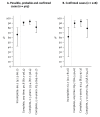A combined cross-sectional analysis and case-control study evaluating tick-borne encephalitis vaccination coverage, disease and vaccine effectiveness in children and adolescents, Switzerland, 2005 to 2022
- PMID: 38699900
- PMCID: PMC11067431
- DOI: 10.2807/1560-7917.ES.2024.29.18.2300558
A combined cross-sectional analysis and case-control study evaluating tick-borne encephalitis vaccination coverage, disease and vaccine effectiveness in children and adolescents, Switzerland, 2005 to 2022
Abstract
BackgroundTick-borne encephalitis (TBE) is a severe, vaccine-preventable viral infection of the central nervous system. Symptoms are generally milder in children and adolescents than in adults, though severe disease does occur. A better understanding of the disease burden and duration of vaccine-mediated protection is important for vaccination recommendations.AimTo estimate TBE vaccination coverage, disease severity and vaccine effectiveness (VE) among individuals aged 0-17 years in Switzerland.MethodsVaccination coverage between 2005 and 2022 was estimated using the Swiss National Vaccination Coverage Survey (SNVCS), a nationwide, repeated cross-sectional study assessing vaccine uptake. Incidence and severity of TBE between 2005 and 2022 were determined using data from the Swiss disease surveillance system and VE was calculated using a case-control analysis, matching TBE cases with SNVCS controls.ResultsOver the study period, vaccination coverage increased substantially, from 4.8% (95% confidence interval (CI): 4.1-5.5%) to 50.1% (95% CI: 48.3-52.0%). Reported clinical symptoms in TBE cases were similar irrespective of age. Neurological involvement was less likely in incompletely (1-2 doses) and completely (≥ 3 doses) vaccinated cases compared with unvaccinated ones. For incomplete vaccination, VE was 66.2% (95% CI: 42.3-80.2), whereas VE for complete vaccination was 90.8% (95% CI: 87.7-96.4). Vaccine effectiveness remained high, 83.9% (95% CI: 69.0-91.7) up to 10 years since last vaccination.ConclusionsEven children younger than 5 years can experience severe TBE. Incomplete and complete vaccination protect against neurological manifestations of the disease. Complete vaccination offers durable protection up to 10 years against TBE.
Keywords: Epidemiology; Immunity; Infectious disease; Paediatric vaccination; Switzerland; Tick-borne disease; Tick-borne encephalitis; Vaccine effectiveness.
Conflict of interest statement
Figures




Similar articles
-
Analysis of Tick-borne Encephalitis vaccination coverage and compliance in adults in Switzerland, 2018.Vaccine. 2020 Nov 17;38(49):7825-7833. doi: 10.1016/j.vaccine.2020.10.022. Epub 2020 Oct 21. Vaccine. 2020. PMID: 33164805
-
Effectiveness of tick-borne encephalitis vaccination in Latvia, 2018-2020: an observational study.Clin Microbiol Infect. 2023 Nov;29(11):1443-1448. doi: 10.1016/j.cmi.2023.06.028. Epub 2023 Jul 6. Clin Microbiol Infect. 2023. PMID: 37422077
-
Self-reported tick-borne encephalitis (TBE) vaccination coverage in Europe: Results from a cross-sectional study.Ticks Tick Borne Dis. 2018 May;9(4):768-777. doi: 10.1016/j.ttbdis.2018.02.007. Epub 2018 Feb 16. Ticks Tick Borne Dis. 2018. PMID: 29501619
-
[Tick-Borne Encephalitis - Viral Transmission and Considerations for Vaccination].Ther Umsch. 2022 Nov;79(9):471-481. doi: 10.1024/0040-5930/a001390. Ther Umsch. 2022. PMID: 36303529 Review. German.
-
TBE vaccination and the Austrian experience.Vaccine. 2003 Apr 1;21 Suppl 1:S50-5. doi: 10.1016/s0264-410x(02)00813-7. Vaccine. 2003. PMID: 12628814 Review.
Cited by
-
Tick-borne encephalitis vaccine uptake, effectiveness, and impact in Sweden from 2018 to 2022.Sci Rep. 2025 Jan 23;15(1):2927. doi: 10.1038/s41598-025-86968-y. Sci Rep. 2025. PMID: 39849089 Free PMC article.
-
Does the Vaccination against Tick-Borne Encephalitis Offer Good Value for Money for Incidence Rates below the WHO Threshold for Endemicity? A Case Study for Germany.Vaccines (Basel). 2024 Oct 12;12(10):1165. doi: 10.3390/vaccines12101165. Vaccines (Basel). 2024. PMID: 39460331 Free PMC article.
References
-
- Swiss Federal Office of Public Health (FOPH). Zahlen zu Infektionskrankheiten - Zeckenenzephalitis FSME. [Infectious diseases statistics - Tick-borne encephalitis TBE]. Bern: FOPH; 2023. German. Available from: https://www.bag.admin.ch/bag/de/home/zahlen-und-statistiken/zahlen-zu-in...
-
- World Health Organization (WHO). Vaccines against tick-borne encephalitis: WHO position paper 2011. Weekly Epidemiological Record, 2011, vol. 86, 24. Geneva: WHO; 2011. Available from: https://www.who.int/publications/i/item/WHO-WER8624
MeSH terms
Substances
LinkOut - more resources
Full Text Sources
Medical
